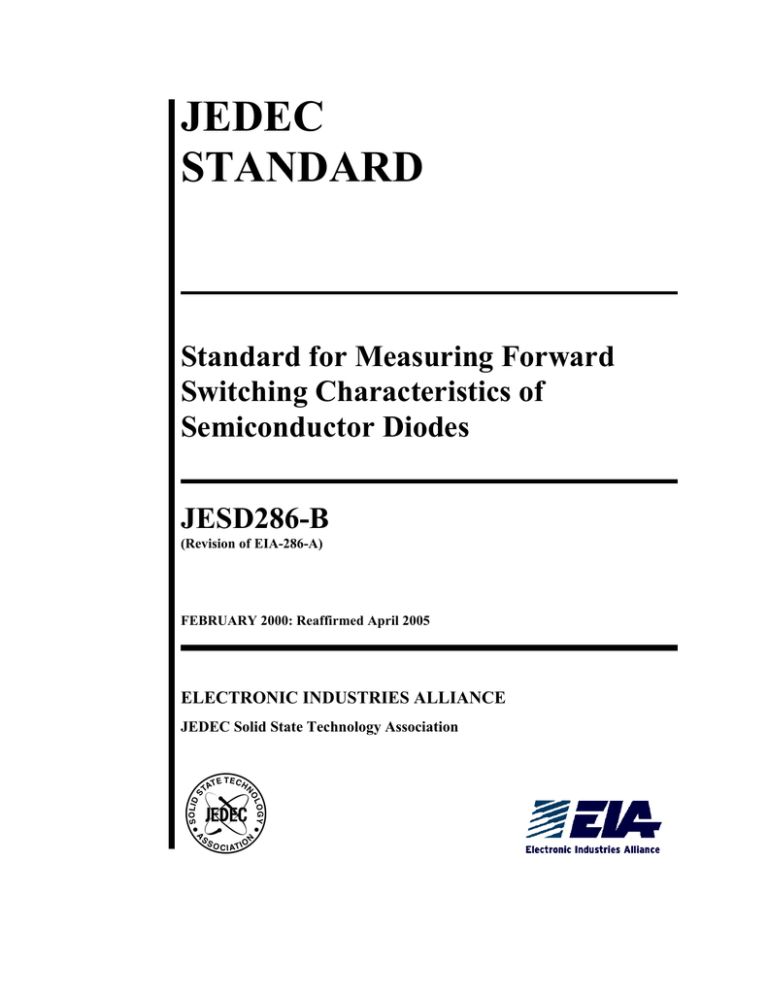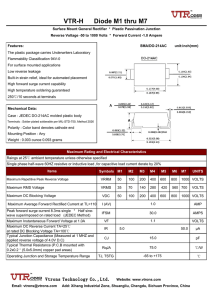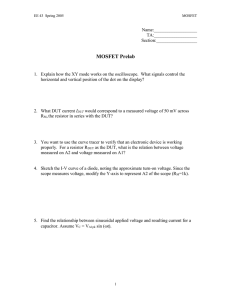
JEDEC
STANDARD
Standard for Measuring Forward
Switching Characteristics of
Semiconductor Diodes
JESD286-B
(Revision of EIA-286-A)
FEBRUARY 2000: Reaffirmed April 2005
ELECTRONIC INDUSTRIES ALLIANCE
JEDEC Solid State Technology Association
NOTICE
EIA/JEDEC standards and publications contain material that has been prepared, reviewed, and
approved through the JEDEC Board of Directors level and subsequently reviewed and approved by
the EIA General Counsel.
EIA/JEDEC standards and publications are designed to serve the public interest through eliminating
misunderstandings between manufacturers and purchasers, facilitating interchangeability and
improvement of products, and assisting the purchaser in selecting and obtaining with minimum delay
the proper product for use by those other than JEDEC members, whether the standard is to be used
either domestically or internationally.
EIA/JEDEC standards and publications are adopted without regard to whether or not their adoption
may involve patents or articles, materials, or processes. By such action JEDEC does not assume any
liability to any patent owner, nor does it assume any obligation whatever to parties adopting the
EIA/JEDEC standards or publications.
The information included in EIA/JEDEC standards and publications represents a sound approach
to product specification and application, principally from the solid state device manufacturer
viewpoint. Within the JEDEC organization there are procedures whereby an EIA/JEDEC standard
or publication may be further processed and ultimately become an ANSI/EIA standard.
No claims to be in conformance with this standard may be made unless all requirements stated in the
standard are met.
Inquiries, comments, and suggestions relative to the content of this EIA/JEDEC standard or
publication should be addressed to JEDEC Solid State Technology Association, 2500 Wilson
Boulevard, Arlington, VA 22201-3834, (703)907-7560/7559 or www.jedec.org
Published by
©ELECTRONIC INDUSTRIES ALLIANCE 1999
JEDEC Solid State Technology Association
2500 Wilson Boulevard
Arlington, VA 22201-3834
This document may be downloaded free of charge, however EIA retains the
copyright on this material. By downloading this file the individual agrees not to
charge or resell the resulting material.
PRICE: Please refer to the current
Catalog of JEDEC Engineering Standards and Publications or call Global Engineering
Documents, USA and Canada (1-800-854-7179), International (303-397-7956)
Printed in the U.S.A.
All rights reserved
PLEASE!
DON”T VIOLATE
THE
LAW!
This document is copyrighted by the Electronic Industries Alliance and may not be
reproduced without permission.
Organizations may obtain permission to reproduce a limited number of copies
through entering into a license agreement. For information, contact:
JEDEC Solid State Technology Association
2500 Wilson Boulevard
Arlington, Virginia 22201-3834
or call (703) 907-7559
JEDEC Standard No. 286-B
Page 1
STANDARD FOR MEASURING FORWARD SWITCHING CHARACTERISTICS OF
SEMICONDUCTOR DIODES
(From JEDEC Board Ballot JCB-99-13 formulated under the cognizance of JEDEC JC-22.4 Committee on
Signal and Regulator Diodes.)
1 Forward switching characteristics
When a step function of forward current (high di/dt) is applied to a signal or switching diode (typically
rated less than 400 mA and less than 150 volts), the carrier gradient does not develop immediately,
resulting in an overshoot voltage that decreases with time to the dc static level. The diode appears to be
inductive; however, transit time and conductivity modulation, not inductance, are responsible for the
effect. The result is an overshoot voltage that decays to the normal forward voltage in a measurable time.
This phenomenon is called forward recovery as described in Section 2 of this Standard.
Forward current-time characteristics are sometimes considered in respect to propagation delay from diodes
in low-impedance, low-voltage, high-speed signal circuits. In these circuits, the transit time and
modulation result in delayed conduction of forward current instead of the forward recovery response noted
above. This behavior relates to turn-on time as described in Section 3 of this Standard.
Both the voltage overshoot and delayed conduction are from the same forward switching phenomenon.
Since the circuits that exhibit such behavior are different in observed response, one must use different test
methods; both are given in this Standard.
2 Forward recovery
Forward Recovery Time, (tfr), is the time interval between the instant when the forward voltage rises
through a specified first value, usually 10% of its final value, and the instant when it falls from its peak
value, VFRM, to a specified low second value, vFR, upon the application of a step current following a zero
voltage or a specified reverse voltage condition.
Peak forward recovery voltage, VFRM, is the maximum instantaneous value across the DUT resulting from
the application of a specified step function of forward current. This characteristic is sometimes referred to
as modulation voltage. Also VF(pk), VFM(DYN), and VFM are sometimes used, but VFRM is preferred.
2.1 Procedure
The DUT is subjected to a specified step function of forward current. The resulting current waveform
through the device and voltage waveform across the device are graphically monitored with amplitude
displayed versus time. The desired characteristics are obtained from the display.
JEDEC Standard No. 286-B
Page 2
2 Forward recovery (cont’d)
2.2 Test circuit and waveform
The general test circuit is shown in Figure 1 and the waveforms in Figure 2.
The current pulse source may be a pulse generator, charged line, pulse-forming network, or the like. If the
nature of the source requires an internal switch, devices such as a mercury switch, power MOSFET or
similar devices may be used. Compliance voltage (open circuit output voltage) of the pulse current source
shall be a minimum 3 VFRM. In any event, the combination must provide the specified conditions of the
pulse to the DUT.
Aberrations of the pulse top shall not exceed +10% of IF. The di/dt of the leading edge shall be measured
between the 10% and 90% amplitude points.
R is a noninductive shunt or current-viewing calibrated resistor. A suitable high frequency current probe
may be used instead. The external switch shown is electronic and is left open if no reverse voltage is
specified; otherwise it is synchronized to be open only for the duration of the current pulse. For these
devices; switching from a reverse bias instead of zero bias usually does not significantly affect the accuracy
of the forward recovery measurement.
It is expedient to observe the waveforms on a suitable dual-channel oscilloscope. The common connection
shown will result in the inversion of the current waveform. Most oscilloscopes provide an inverted display
switch to yield the waveforms as shown.
2.3 Test conditions to be specified
a. Rise time of current pulse (measured from 10% to 90% of IFM), tr = _____Fs
b. Peak forward current, IF = ______A
c. Forward recovery voltage defining the end of the forward recovery time, if different from 1.1 times
VF, vFR = ___V. See notes for guidelines.
d. Test current pulse duration, tp = _____s
e. Test repetition rate, f = _____pps (1000 max)
f.
Reverse voltage prior to application of current pulse, VR = _____V
g. Case temperature, TC = _____oC
or
Lead temperature, TL = _____oC
JEDEC Standard No. 286-B
Page 3
2 Forward recovery (cont’d)
2.3 Test conditions to be specified (cont’d)
h. Maximum thermal resistance of heat dissipator upon which the DUT is to be mounted, Rth = _____oC/W
NOTES
1 If VFRM is expected to exceed 10 V, select vFM = 3 times the expected value of VF.
2 If VFRM is expected to be less than 1.3 V, select vFR = 0.5 (VFRM - VF) + VF
2.4 Characteristics to be measured
a. Forward recovery time, tfr = _____s
b. Peak forward recovery voltage, VFRM = _____V
c. DC forward voltage, VF = _____V
Switch
+
DUT
-
Current
pulse
source
-
To oscilloscope
channel B
+
R
To oscilloscope
channel A
(inverted)
Figure 1 — Forward switching characteristics test circuit
vR
JEDEC Standard No. 286-B
Page 4
2 Forward recovery (cont’d)
2.4 Characteristics to be measured (cont’d)
IFM
0.9|FM
0.9IFM
I
0.1|FM
tp
tr
Channel A
VFRM
vFR
(1.1VF unless otherwise specified)
V
VF
0.1VF
tfr
Channel B
VFRM
vFR
(1.1VF unless otherwise specified)
V
VF
0.1VF
tfr
Channel B
VR
Figure 2 — Forward switching characteristics waveforms
JEDEC Standard No. 286-B
Page 5
3 Forward turn-on-time
The forward turn-on time (ton) is defined as the time required for the forward current of the diode to reach
90% of its final predetermined value, when the diode is switched from zero to forward bias. If the diode is
switched from a reverse bias state to a forward bias, the forward turn-on time (ton) is measured from the
time the current crosses zero to 90% of its final predetermined value.
3.1 Procedure
The forward turn-on time may be measured by observing the forward current waveform on an oscilloscope
in response to a square wave which switches the diode from zero or reverse bias to forward bias. A circuit
which can be used for this test is shown in Figure 3. The waveforms which are generally observed are
shown in Figure 4 or Figure 5.
3.2 Circuit description and requirements
RS
DUT
+
Voltage
pulse
source
-
VIN
RL
Oscilloscope
Rs = Source output resistance
RL = Load Resistance
Figure 3 — Forward turn-on time test circuit
JEDEC Standard No. 286-B
Page 6
3 Forward turn-on-time (cont’d)
3.3 Requirements of circuit components (refer to Figure 3 for symbols)
When the diode is replaced by a short circuit, the response time from zero to 90% of IF shall be less than
10% of the specified ton maximum of the diode being tested.
If the above conditions cannot be met, the turn-on time will be a function of the rise time of the input
voltage pulse; thus the rise time of the input pulse must be specified.
The duration of the input voltage pulse shall be at least 10 times the ton maximum for the device being
tested.
The duty factor of the voltage pulse shall be low enough so that negligible heating occurs.
The load resistor, RL, should be chosen such that RL + RG = 100 ohms, unless otherwise specified.
3.4 Calibration procedure
Insert a diode representation of the diodes to be tested into the test clips and adjust VIN and RL until the
desired steady-state forward current (IF) has been obtained.
IF =
VIN − VF
, where VF = forward voltage of the diode at IF.
RL
If the forward voltage of the diode varies considerably from diode to diode, a slight adjustment of VIN may
be required to maintain IF constant for each diode.
Adjust the oscilloscope to the proper ranges for observing the turn-on time and the amplitude of IF. The
total sweep time of the oscilloscope should be at least twice the measured turn-on time when establishing
the amplitude of IF (steady-state). This will aid in determining the 90% IF point. The deflection due to IF
should be at least 1/2 full scale of the detector.
3.5 Measurement
If the diode is switched from zero to a forward bias state, a current waveform similar to Figure 4 should be
displayed on the oscilloscope. The forward turn-on time (ton) is measured by determining the time required
for the forward current to reach 90% of its final value. This is shown graphically in Figure 4.
If the diode is switched from a reverse bias state to the forward bias state, a current waveform similar to
Figure 5 should be displayed on the oscilloscope. The forward turn-on time (ton) is measured by
determining the time required for the forward current to increase from zero to 90% of its final value. This
is shown graphically in Figure 5.
JEDEC Standard No. 286-B
Page 7
3 Forward turn-on-time (cont’d)
3.5 Measurement (cont’d)
VIN
Amplitude
Diode forward current
0.9IF
0
ton
Time
See Note on page 8
Figure 4 — Current and voltage waveforms for ton measurement with no initial reverse bias
IF
JEDEC Standard No. 286-B
Page 8
3 Forward turn-on-time (cont’d)
3.5 Measurement (cont’d)
VIN
Amplitude
IF
0.9IF
See
Note
0
ton
Time
t
VR
Figure 5 — Current and voltage waveforms for ton measurement with initial reverse bias
NOTE — Although in Figures 4 and 5, current and voltage cross the zero axis at slightly different
points, this difference does not significantly affect the accuracy of the measurement.



